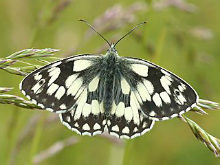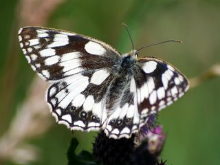

Marbled WhiteMelanargia galatheaWidespread in Hertfordshire 
Distribution and Status The Marbled White is one of our major success stories since the 1980s in our branch area. In the 1980s it was mostly only found in the west of Hertfordshire with just a few scattered colonies elsewhere. The spread started from the Tring area and is now found in most of Hertfordshire including the far north-east. The spread into Middlesex also began in the 1990s and the butterfly is now widespread in the county apart from the south-west and central areas of London. There has been a marked increase in abundance since the mid 1990s. It appears that the butterfly is more able to adapt to breed on road verges, field margins and woodland clearings as well as continuing to thrive on calcareous grasslands, if the grass sward is kept reasonably tall. It has now turned up in some suburban gardens. Habitat Requirements Unimproved grasslands, woodland rides, road verges, railway cuttings and waste ground where the grasses are maintained at a tall height. Management is required to ensure that the vegetation is not too overgrown to allow a good mix of fine grasses to grow and taller ones to form tussocks Larval Foodplants Red Fescue Festuca rubra. Other plants occasionally used include Sheep's Fescue F. ovina, Timothy Phleum pratense, Cock's-foot Dactylis glomerata and Tor Grass Brachypodium pinnatum Adult Food Sources Buddleia Buddleja davidii, Field Scabious Knautia arvensis, Common Knapweed Centaurea nigra Behaviour/Observation notes The Marbled White is very conspicuous and hard to miss when in flight which is slow and flapping. It is easy to approach when basking on grass or flower-heads. For taking pictures of the uppersides visit a known site in the morning, late afternoon or in dull weather 
Life History Only one generation is produced each year with the butterfly on the wing between the middle of June and early August, and a peak usually in the first week of July. Mated females sit on tall stems and release the eggs on tall vegetation - they do not lay on the foodplant. After the larva eats the eggshell it enters hibernation then begins feeding in the spring. The pupa is formed on the ground Further information
Photo gallery |